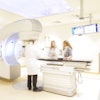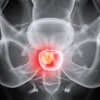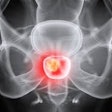The field of prostate cancer research is currently abuzz with advances in both diagnosis and treatment. First, researchers at Los Angeles' University of Southern California have developed a prostate cancer vaccine. The vaccine, which mounts an immune response against prostate stem cell antigen, prevented cancer from developing in 90% of the mice that carried the disease (Cancer Research, February 1, 2008, Vol. 68:3, pp. 861-869).
Another group, from the University of Michigan in Ann Arbor, worked with a biomarker-based prostate cancer screening tool that turned in more accurate results than the standard prostate-specific antigen (PSA) test. The team's urine analysis test essentially hunted down prostate-specific genes that overexpressed themselves (Cancer Research, February 1, 2008, Vol. 68:3, pp. 645-649).
On the treatment front, a report released by the Agency for Healthcare Research and Quality claimed that no one therapy is better than another for fighting prostate cancer. The report consisted of a meta-analysis of 592 published articles and compared eight prostate cancer treatment strategies, including radiotherapy, brachytherapy, cryotherapy, and surgery.
Among the report's conclusions was that all treatment options cause health problems, and that a lack of research made it difficult to compare multiple treatment regimens head-to-head (Annals of Internal Medicine, February 5, 2008).
Fortunately, two studies have been released that boost the body of literature on the efficacy of prostate cancer treatment. In the Journal of the American Medical Association, Dr. Anthony D'Amico, Ph.D., and colleagues reported the second round of results from a randomized trial comparing androgen suppression therapy (AST) plus radiation therapy to radiotherapy alone. And in the International Journal of Radiation Oncology, Biology, Physics, Dr. Deborah Kuban's group outlined the long-term results of a randomized dose-escalation trial.
AST, RT, and comorbidities
In 2004, D'Amico's multi-institutional group stated that "the addition of six months of AST to 70 Gy 3D conformal (radiation therapy) confers an overall survival benefit for patients with clinically localized prostate cancer" (JAMA, August 18, 2004, Vol. 292:7 pp. 821-827).
This year the group updated those results, looking specifically at AST and radiation therapy versus radiotherapy, and how those two treatment arms interact with comorbidity and all-cause mortality.
"AST administration is associated with an increased risk of fatal and nonfatal cardiovascular events in men of advanced age," the authors wrote in their latest study (JAMA, January 23, 2008, Vol. 299:3, pp. 289-295).
Their patient population consisted of 206 men at multiple community-based and academic clinics, including Boston's Dana-Farber Cancer Institute, where D'Amico is based. The patients had a median age of 72.5 years and were treated between 1995 and 2001.
Patients were deemed stage T1b to T2bN0M0 based on American Joint Commission on Cancer (AJCC) criteria. In addition, each patient had at least one unfavorable prognostic factor such as a PSA level of more than 10 ng/mL, evidence of extracapsular extension, or seminal vesicle invasion based on endorectal MR imaging. They were then randomized to receive radiation alone or in combination with six months of AST.
D'Amico assigned a comorbidity score to each individual patient, then an overall score was assigned. Patients were followed up every three months for two years, every six months for another three years, and then annually. The median date for the last follow-up was September 2006. Cause of death was determined by the attending oncologist with the caveat that a death by prostate cancer could be recorded only if hormone refractory cancer and rising PSA were documented.
As of January 2007 and a median follow-up of 7.6 years, 74 of the 206 men died. Of those 74, 44 were among those randomized to radiotherapy alone and 30 were men who received the combined therapy. Also of the 74, 18 were attributed to prostate cancer: 14 in the radiation group and four in the combination group. The authors found that the estimates of overall survival were significantly higher for men who received AST and radiotherapy (74% Kaplan-Meier estimate).
In addition, men who received only radiotherapy had an increased risk of prostate cancer-specific mortality, which translated to an increased risk of all-cause mortality. Finally, the researchers found no significant differences in the distribution of comorbidity scores.
Of the 157 men with minimal or no comorbidities, 40% died of prostate cancer. In this segment, the authors calculated a 13% absolute improvement in overall survival at eight years for those treated with radiation and AST, and a 26% improvement for those treated with just radiotherapy.
Among the 49 men with moderate to severe comorbidities, 3% were due to prostate cancer. The authors noted that "prostate cancer was not a major contributor to all-cause mortality in men with moderate to severe comorbidities."
However, the men who received combination therapy did not have prolonged survival. These results are in line with previous research indicating that AST may not be as beneficial in older men, the authors stated. "The clinical significance of this finding is that the pre-existing comorbid illness may increase the negative effects of specific anti-cancer treatments such as AST," they wrote.
Future studies in this area will have to look at the impact of specific types of comorbidities, as well as health-related quality-of-life issues that may outweigh life expectancy.
Dose escalation
From 1993 to 1998, a radiotherapy dose-escalation trial for treating prostate cancer was conducted at the M. D. Anderson Cancer Center in Houston. The hypothesis for this study was that delivering 78 Gy versus 70 Gy would result in an absolute increase in freedom from failure of at least 15% of patients treated with external-beam radiation therapy (EBRT). The first round of results was published in 2000 and demonstrated the anticipated benefit of a higher dose for tumor control (Journal of Clinical Oncology, December 1, 2000, Vol. 18:23, pp. 3904-3911).
For the current study, Kuban's group analyzed follow-up data up to 12 years after treatment in 301 patients with AJCC T1b to T3 prostate cancer. Patients were stratified to either the 70 Gy or 78 Gy arm. Stratification was based on pretreatment PSA levels. The primary end point of the trial was freedom from clinical and/or biochemical failure.
Based on the long-term follow-up, freedom from biochemical failure or clinical failure was significantly different for the 78 Gy group than the 70 Gy group. This difference increased over time for the 78 Gy group as shown below.
|
The authors also noted that those patients with a PSA greater than 10 ng/mL derived the greatest benefit from dose escalation. At eight years postradiation, the low-risk patients treated with 78 Gy had a freedom from failure rate of 88% compared with 63% for those treated with 70 Gy. This trend toward higher dosage and better freedom from failure rates was also seen in patients with intermediate- and high-risk disease.
"There was a significant difference in clinical failure based on dose as well. Of the patients, 93% treated to 78 Gy were clinically disease-free at eight years post-treatment as compared with 85% of patients who were treated to 70 Gy," the group wrote. Also, "freedom from distant metastasis after 70 Gy versus 78 Gy was 95% versus 99%" (IJROBP, January 1, 2008, Vol. 70:1, pp. 67-74).
With regard to toxicity, those treated with 78 Gy did have a higher 10-year incidence of grade 2 or greater toxicity. However, the authors noted that at the time of the study, normal tissue dose-volume guidelines had not been defined.
The trial results did not indicate a significant difference in overall survival between the two treatment arms. But more patients from the 70 Gy group either died of their cancer or are alive with the disease eight years later, the group stated, adding that "to date, no randomized trial has documented a survival advantage to higher radiation dose, including our study."
In the 78 Gy group, more deaths occurred due to other causes, which calls attention to the importance of comorbidities, the authors stated. Their study results reiterated the value of a higher radiation dose, particularly in patients with low-risk disease.
By Shalmali Pal
AuntMinnie.com staff writer
February 14, 2008
Related Reading
Pelvic node irradiation does not improve survival in localized prostate cancer, December 21, 2007
MR imaging-guided galvanotherapy promising for prostate cancer, November 28, 2007
ASTRO: Younger men benefit from prostate brachytherapy, November 1, 2007
Risk factors for prostate cancer mortality after biochemical recurrence identified, July 25, 2005
Copyright © 2008 AuntMinnie.com



















